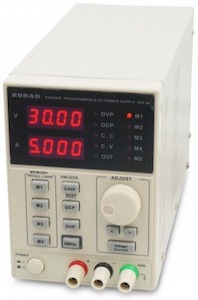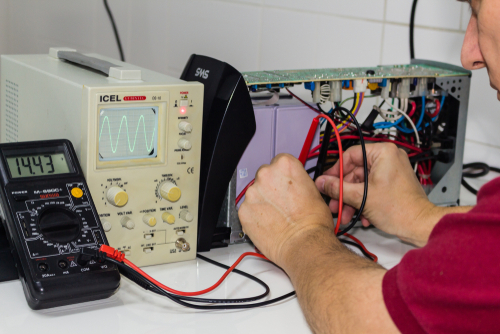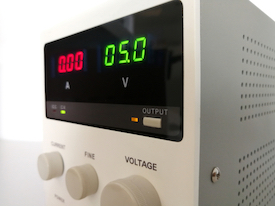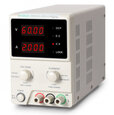A Comprehensive Guide to Bench Power Supply

Figure 1: Bench power supply
A bench power supply is a tool used by electricians and circuitry architects to power, test, and measure circuit designs. A bench power supply is a tool that converts alternating current (AC) to direct current (DC). This article discusses the working of a benchtop DC power supply and how to find the ideal one for a particular application.
Table of contents
- What is a bench power supply
- Bench power supply features
- Different types of bench power supplies
- How to use a bench power supply
- Selection criteria
- Conclusion
- FAQs
View our online selection of power supplies!
What is a bench power supply
A Bench power supply is a tool that converts Alternating Current (AC) to Direct Current (DC). It is typically used to test equipment in lab benches. It has much more controlled voltage, thus protecting circuits under test. Compared to consumer power supply systems, a bench power supply allows tighter regulation of current and voltage levels, shielding circuits under test, and multiple concurrent connections to circuits and portions of circuits.
Bench power supply features
A Bench power supply has a lot more current and voltage control than standard AC-DC wall bugs and converters. They are a reliable power supply that doesn't compromise the functioning of the circuits they're powering, allowing the user to concentrate on design and diagnostics.
Most bench power supplies offer fine and coarse adjusters, enabling precise control of the required DC output. Bench power supplies also have voltage limitations and precise voltage control. The production of certain bench power supplies is stored in memory or regulated by an external computer to support continuous or protracted testing.
The two basic modes of operation of a bench power supply are:
- Constant current: In a constant current setting, the power supply will retain the preset current despite fluctuations in resistance.
- Constant voltage: When the supply is configured to constant voltage, the voltage will be maintained no matter how high the resistance.
The circuit consumes energy inside the supply's specifications in each mode. These modes can be helpful when a circuit needs to be tested while limiting the current from the power supply, potentially sparing the circuitry from harm if anything goes wrong.
Different types of bench power supplies
Even though benchtop power supplies come in a variety of configurations, there are three main groups:
- Single and multi-channel power supplies: A single-channel power supply has one controllable output, making them less flexible and cheaper. A multi-channel power supply has two or more controllable outputs. Multiple controllable outputs are suitable for analog and digital circuitry usage while working on devices requiring various voltage inputs.
- Bipolar and unipolar power supplies: A unipolar power supply can generate only positive voltage. A technician can manually switch the terminals connected to the electricity source to generate a negative voltage. However, bipolar power supplies work in both types of energy environments. Consequently, they can handle a broader range of practical applications, including the development of magnetic materials for vehicle motors, testing of bidirectional inverters, and testing of laser diodes. They are, however, much more expensive and complicated as a result of this.
- Linear and switching power supplies: It's worth noting that linear power supply can produce high-accuracy readings with low signal distortion. However, due to their size, they are not as effective as switching power supply. A linear power supply often employs a big transformer to convert voltage from an AC line to a considerably lower AC voltage, then rectified and filtered to generate a clean DC voltage. Although somewhat less precise, alternate power supplies can supply high amounts of power in a more condensed, energy-saving manner.
When power density is a concern, a switching power supply is utilized since it can deliver substantially more watts with a lower footprint, but a linear power supply is employed where delicate analog circuitry needs to be powered.
How to use a bench power supply
Technicians can select voltages or levels of current to operate the device under testing through the front panel display.
Setting current
Setting the current is critical because the circuit may get damaged if it receives too much current. Turn the current and voltage knobs anticlockwise, and the letters ‘cc’ on the display stands for continuous current. Rotate the current knob clockwise to the required level and then unclip the leads.
Setting voltage
Setting the voltage is a simple task. Crank the voltage knob clockwise to the desired level. The power supply is now operational.
A multimeter can be used to monitor the output voltage at regular intervals in a conventional supply. Programmable power supplies have a built-in display that shows all the essential information, such as current-voltage, set amp, mode of operation, and many other variables.
Number of outputs
Multiple output power supplies with high accuracy have grown more economical, but it's essential to consider which applications require them and which don't. Although a single output is adequate in many applications, multiple-output supplies can occasionally provide many significant benefits:
- When designing a device with analog and digital circuitry or bipolar circuit design, a multiple-output supply will be the most helpful power source. Two higher-voltage analog circuit outputs and a third output meant to feed a digital circuit are standard features of power sources with three outputs.
- Many power supplies with three outputs keep the 3rd output source at a constant 5V (this provides the best blend of power consumption, noise immunity, and speed with existing technology). The third output cannot be utilized to power the digital circuitry if the voltage has to be adjusted or if a lower voltage energizes the circuit. As a result, ensure that all three outputs are configurable for the highest versatility.

Figure 2: Using a multimeter to monitor output voltage
Selection criteria
Response time
Response time is crucial for testing with quickly changing voltages. The response time is the time taken by the device to raise or decline to a particular voltage. This varies depending on the load. Pick a supply system that fits the particular application.
Remote sense voltage monitoring
It's best to employ a power source with a remote sensor to get the most precise voltage supply. Remote sense voltage monitoring obtains measurements at the Device Under Test rather than at its input ports by correcting voltage loss from the test terminals. This provides a much cleaner reading.
Programmability
Completely programmable power supplies allow users to utilize pre-programmed setting. This feature enables technicians to focus on the text itself rather than spend time configuring their power supplies.
Noise
Ripple is the periodic AC of your power supply's output, and ripple appears as false responses. The only difference between ripple and noise is that noise is random. Ensure to pick a power source that generates low noise and ripple that creates more clarity in the work environment.
Shutdown memory
To save the precious readings and configurations, Ensure to pick a system that has shutdown memory incorporated. This will ensure all your data is securely stored.
Overheating protection
Overheating can lead to the power supply shutting down. Choose a device that has overheating protection. This will guarantee a longer life of service.

Figure 3: A bench power supply delivers reliable, clean, and regulated energy
Conclusion
When it comes to activating a circuit or any electronic equipment for restoration, diagnosis, or examination, a bench power supply is the tool to revert to. They deliver reliable, clean, and regulated energy so you can concentrate on the circuitry rather than the supply. Whenever a circuit has a power-related failure, using the supply's configurations and measurements might be quite helpful. A bench power supply's adaptability and control make it a robust tool for engineers, designers, and technicians in manufacturing, repair, or development setting.
FAQs
What is the difference between a power supply and charger?
A power supply provides a constant voltage to static circuits, while a charger is designed to supply continuous regulated current to devices such as mobile phones.
What is a constant current LED driver?
These devices optimize light output while reducing LED stress, resulting in steady, even illumination.





